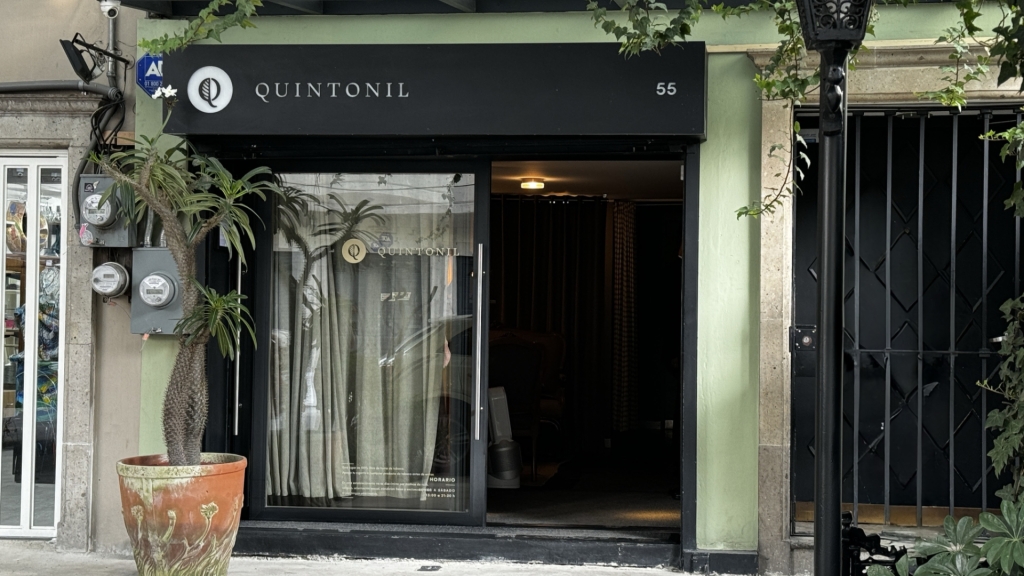
Quintonil is one of two restaurants the inaugural Michelin Guide Mexico awarded two stars. This is the latest in a long list of awards and other accolades it has won since it opened in 2012.
We’ve dined at Pujol, the other restaurant that Michelin awarded two stars, but Quintonil has been high on our list since we began exploring the Mexico City food scene. And now that we’ve visited both, we understand why they are routinely compared. They are both world-class dining experiences, far removed from the inexpensive street food for which Mexico City is famous.
When we learned about Michelin Guide coming to Mexico, we immediately set out to reserve a table during our June 2024 trip. Here’s how we did that, what we ate and drank, how much we spent, and what we thought.
How can you book a reservation?
Getting into Quintonil is not easy.
And we’ve tried before: In summer 2023, we got on the waitlist at Quintonil about three weeks ahead of time and still didn’t get a table. So, if you want to have a meal here, try to make a reservation as soon as you can, and don’t be too picky about the day or time.
We made our reservation on May 17 and booked dinner for 5:45 pm on Tuesday, June 12. That’s early for dinner in Mexico, but it was the closest we could get to a dinner reservation for any day during our three-and-a-half-week trip.
You can reserve on Quintonil’s website through Tock, an online reservation service. In a search we did on June 13, there were only three timeslots open in June and nothing at all for the first three weeks of July. More options opened up in late July and early August, which was the furthest out you could book then.
What’s on the menu?
Quintonil offers customers a choice of two tasting menus, and you must decide when you make your reservation. They are:
- Barra—kitchen counter experience. Groups of one to four people can sit at Quintonil’s bar with a view of the kitchen, watching the action. With this option, you pay for your meal when you book the reservation.
- Main dining room. Groups of two to six people can have the seasonal tasting menu at a table in the main restaurant. For this reservation, you pay a deposit of $1,000 MXN per person ($54 USD at the time of this writing). The deposit gets credited to your dinner bill.
You can request vegan, vegetarian, or pescatarian options when you place your reservation.
How much should you expect to spend?
Dining at Quintonil isn’t cheap, and the wine pairings add a lot to the total. Here’s a rundown of the prices per person:
Barra
- Tasting menu: $4,500 MXN ($244 USD)
- Menu with non-alcoholic drink pairing: $5,800 MXN ($314 USD)
- Menu with seasonal wine pairing: $6,825 MXN ($370 USD)
- Menu with Soigné wine pairing: $9,110 MXN ($494 USD)
Main dining room
- Tasting menu: $4,100 MXN ($222 USD)
- Menu with non-alcoholic drink pairing: $5,400 MXN ($293 USD)
- Menu with seasonal wine pairing: $6,425 MXN ($348 USD)
- Menu with Soigné pairing: $7,569 MXN ($410 USD)
What should you wear?
Quintonil doesn’t have a formal dress code, but you will feel out of place if you don’t dress up at least a bit. Business casual or a dress shirt and nicer jeans are fine. Of course, it is a fine dining experience, so if you want to go all-out you can.
We saw mostly dresses (but not gowns) on women and button-down shirts and jeans or pants on men.
Do they speak English?
Yes. When you arrive and they greet you, they ask if you want your service in English or Spanish. Even though we usually like to practice our Spanish in restaurants, we chose English so we could better understand all the ingredients and the preparations.
What’s the food like?
Part of the appeal of Quintonil is the element of surprise, so if you’re planning a meal there you may want to just let it unfold.
If so, stop reading here.
The menu changes seasonally. We had the main dining room menu in June 2024. Here’s what in included, along with our thoughts:
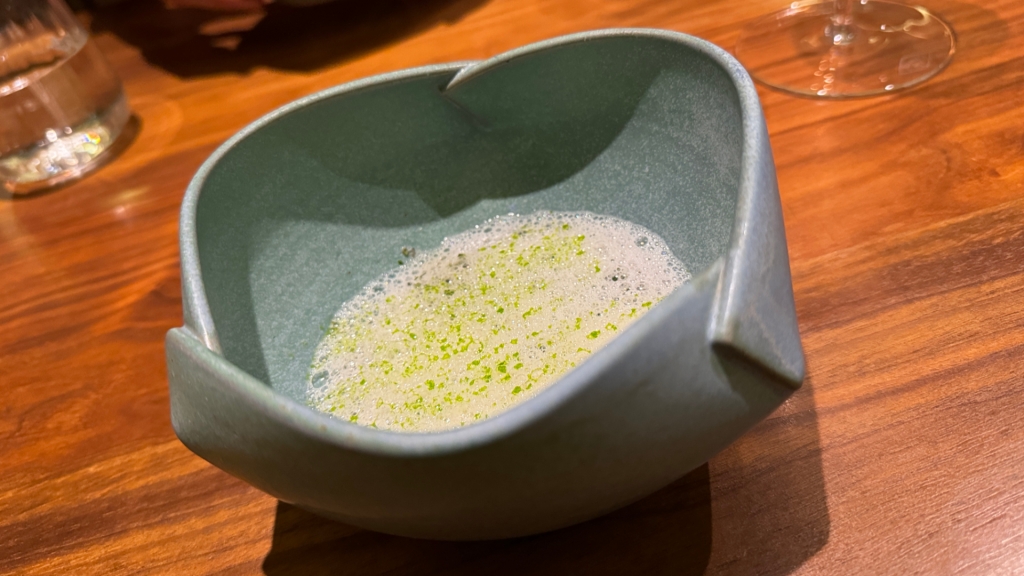
Corn and turnip chilled atole with Mexican herbs. Right from the start, it was clear this was going to be an experience. Two servers came to the table, each with a bowl of atole, a beverage that’s traditionally served warm. They told us to swirl the liquid around in the bowls before we drank it, which combined the ingredients and created nice “legs” along the side of the bowl. It was a delicious start to the meal.
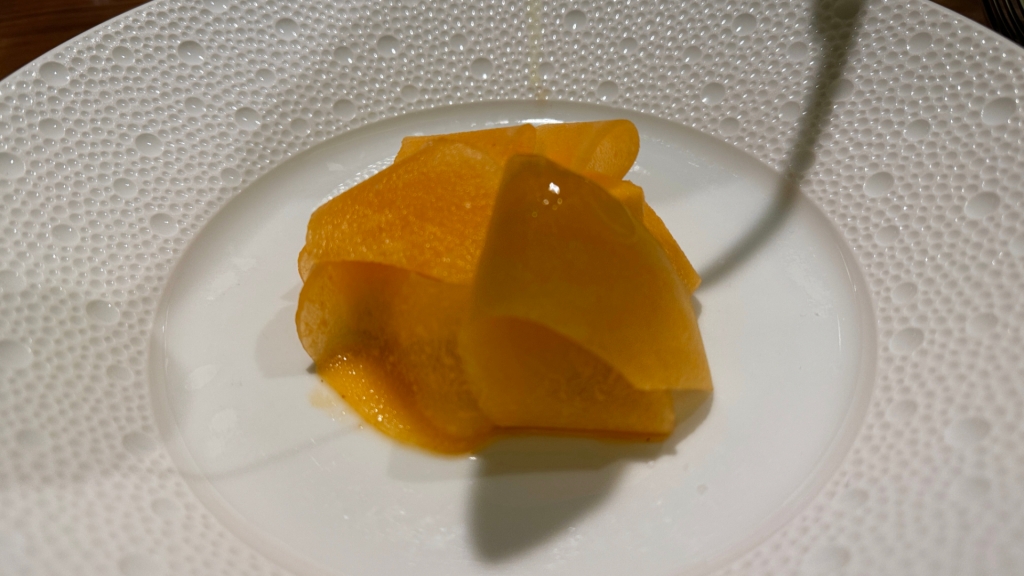
Melon and tomato salad, rice horchata, and pumpkin seeds. This small course was perfectly balanced—the melon and horchata were sweet, the tomatoes added a bit of acidity, and the pumpkin seeds delivered a nutty crunch.

Blue fin tuna, aguachile de brassicas, wasabi iced powder, pickled watermelon radish, and spring herbs. We’re seafood fans, so this tuna dish was a hit, and the flowers made the presentation beautiful. What put this dish over the top was the wasabi iced powder, which was sprinkled on at the table to add a crisp chill.

Pibil duck tamal with young corn cream. This was phenomenal. The slow-cooked duck in the tamal was ridiculously delicious and the corn cream complemented it perfectly. It was served on a banana leaf, as pibil is traditionally cooked slowly in banana leaves.

Entomophagy festival: Vegetable ceviche in smoked cactus leche de tigre; charred avocado tartare with escamoles; oyster mushrooms alambre with salsa macha and grasshopper chintextle; santanero beans from Oaxaca and confit onions; abalone homemade chorizo; salsa roja with jumiles and epazote; striped bass barbacoa in adobo de chapulín, grilled green beans, cauliflower cream; criollo corn tortillas from Opichen, Yucatán. After the first four courses, we started to feel like we had a good sense of how this meal was unfolding—small, delicious dishes one after the other. And then the first main course arrived. Someone had removed the flowers from our table, and we realized they needed all the space to cover the surface with small plates and bowls. This is like the fanciest build-your-own taco bar you’ll ever see. We liked and ate everything, but the striped bass, cauliflower cream, oyster mushrooms, and veggie ceviche were standouts. Lots of insects are included in this course: Entomophagy means the practice of eating insects (we looked it up). But they are mostly ground or blended, not whole. The word they used to describe escamoles (ant eggs) was maggots—we could have done without that translation.

Braised oxtail in recado negro panucho, almond purée, and red onion. For the second main course, we were back to one plate, which was plenty. This was another delicious dish—the panucho is an open tortilla with toppings. Brown butter poured over the top at the table was an amazing finishing touch.
Cactus paddle sorbet. Of course, we needed a palate-cleansing sorbet between the savory dishes and the desserts, and what better ingredient to use than nopales?

Crème fraîche and melipona bee honey, passion fruit, and caviar. This was one of the most interesting dishes on the menu. We each got a wooden spoon filled with honey, and we ate the honey first, then used the spoon for the dessert. That gave us the taste of the honey along with all the other flavors. The ingredients worked together really well, and the caviar added a nice crunch without any noticeable fish flavor.
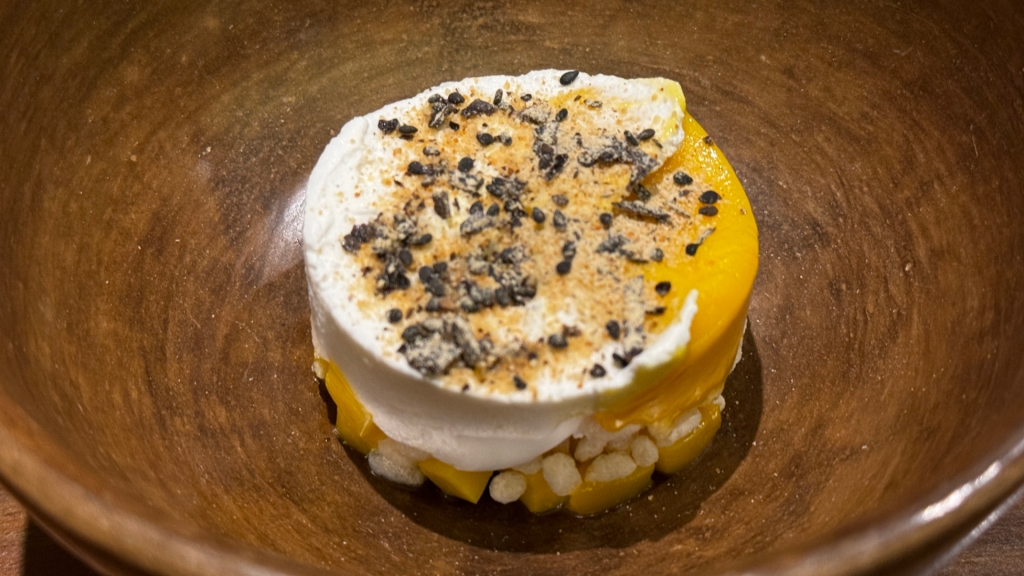
Mango colado, toasted rice, and seaweed. For the second dessert, another nice blend of flavors and textures.
Mamey fruit panna cotta tartelette, and pixtle cream along with 71% chocolate Soconusco Chiapas cookies and vanilla from Veracruz. The final dish was two treats, a delicious little tart and some chocolate chip cookies. We were offered more cookies, but we didn’t need anything else to eat.
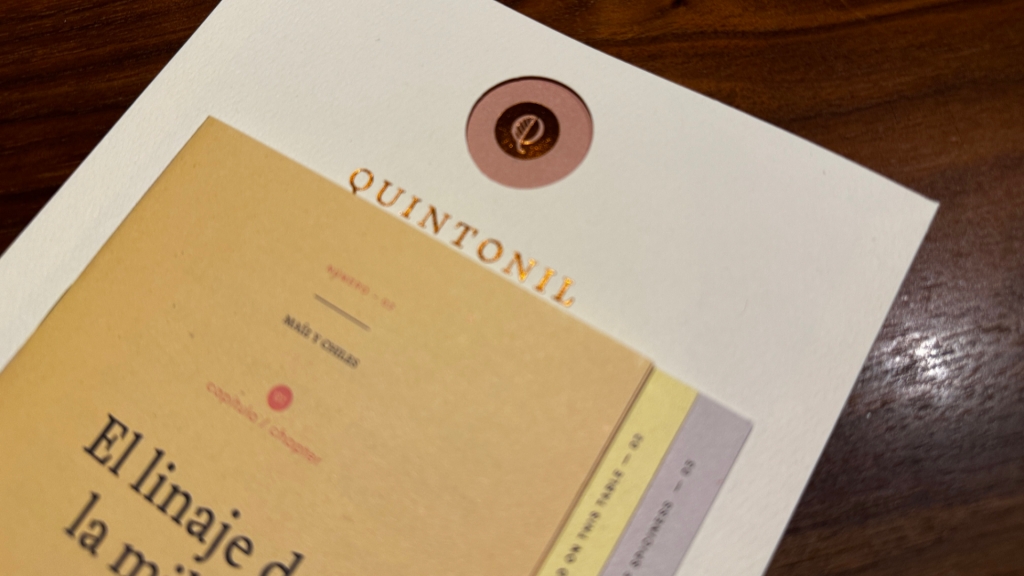
Bonus: We were handed a few gifts as we left the restaurant. There was a sweet potato conch topped with cinnamon for each of us, copies of the food and wine menus, a booklet highlighting some of the restaurant’s ingredients, a list of other places they recommend in Mexico City, and a little sheet they use to track your service that has your name, number of people, language, any allergies, the time each dish was served, and whether you are celebrating a birthday or anniversary.
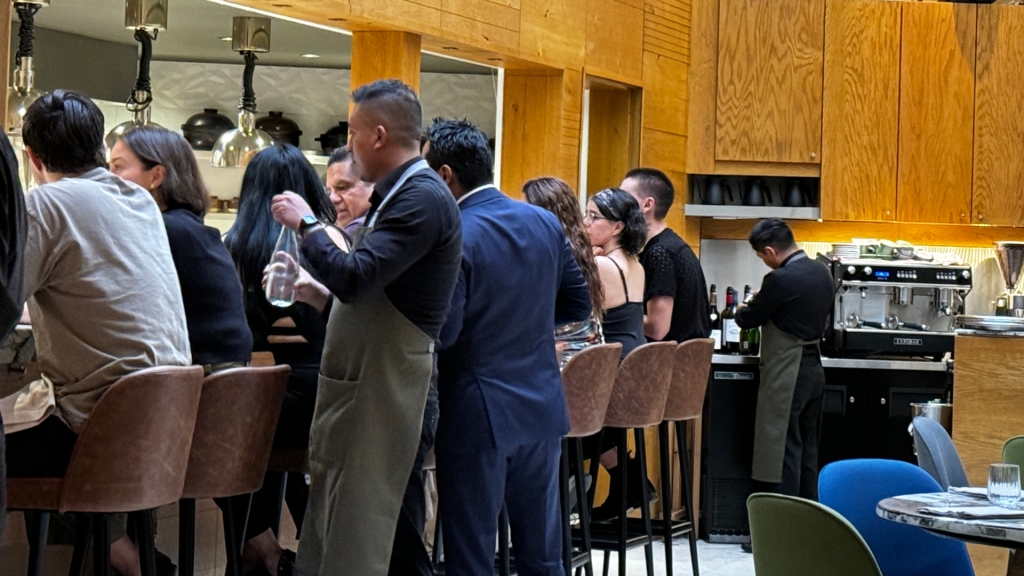
And here’s the barra menu. We didn’t experience this, but you can see there was a mix of dishes from the main dining room menu sprinkled in:
- Corn and turnip chilled atole with mexican herbs
- Blue fin tuna, aguachile de brassicas , wasabi iced powder, pickled watermelon radish, and spring herbs
- Stone crab in pipián verde, with sunflower seeds, makrut lime, and Thai basil, blue corn tostadas
- Grilled pickled mussels tostada, mole del mar, and charred onion sauce
- Pibil duck tamal with young corn cream
- Entomophagy festival: Vegetables ceviche in smoked cactus leche de tigre; charred avocado tartare with escamoles; santanero beans from Oaxaca and confit onions; abalone homemade chorizo; oyster mushrooms alambre with salsa macha, chintextle de chapulín; salsa roja with jumiles and epazote; criollo corn tortillas from Opichen, Yucatán
- Red lobster from Baja California, with chilhuacle rojo and orange gastric, kohlrabi, and plankton cream
- Beef tongue chalupa, salsa de chile morita, and heirloom avocado
- Cactus paddle sorbet
- Crème fraîche and melipona bee honey, passion fruit, and caviar
- Mango colado, toasted rice, and seaweed
- Mamey fruit panna cotta tartelette, pixtle cream along with 71% chocolate Soconusco, Chiapas cookies and vanilla from Veracruz
What can you drink?
The Soigné wine pairing included seven wines from quality producers from around the world:
- Oremus, Petracs-Furmint, Tokaji, Hungary, 2018
- Vinirari, Blend, Valle D’acosta, Italy, 2023
- Viña Tondonia, Rose, Haro, Spain, 2022
- Alfalfa, Valle de Guadalupe, Mexico, 2019
- The Meeker, Zinfandel, California, USA, 1999
- Krug, Champagne AOC, France
- Klein Constantia, Constantia, Sudafrica, 2008
The seasonal wine pairing included seven wines from smaller producers, all of which were organic and biodynamic wines:
- Aura, Pinot Blanc-Pinot Gris, Oregon, USA 2017
- Alpamanta, Sauvignon Blanc, Mendoza, Argentina, 2023
- Bodegas Cota 45, Palomina, Andalucia, Spain, 2022
- Bodegas Del Viento, Pinot Noir, Arteage, Coahuila, Mexico, 2021
- Le Petit Clos, Colchagua, Chile, 2016
- Nicolad Maillart, Premier Cru, Blend
- Copenhagen Sparkling Tea Company, Vinter, White, Black and Chai tea
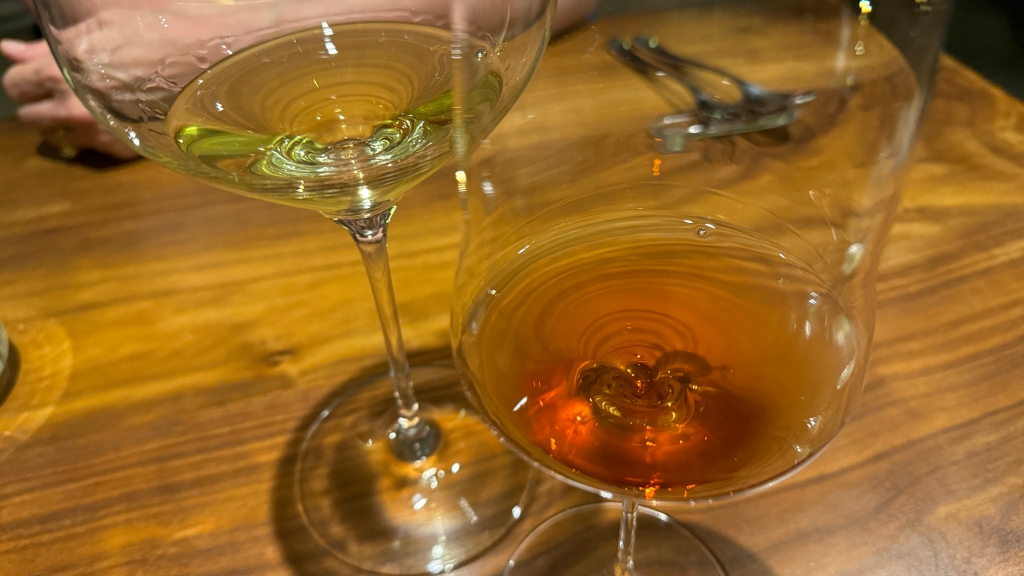
Both of the wine pairings were excellent, and the wines were all interesting. The sommelier explained each wine as she served it. In a few cases, when we first tasted the wine, we weren’t sure if we liked it, but once we tried it with the food, we realized how well it paired. One exception: The Meeker, a 1999 wine, tasted like it was past its peak.
Each wine was served in a different type of glass, a nice touch that highlighted the aroma and flavors of each wine.
Quintonil also has a drink and wine menu (Spanish) that includes wines by the glass and bottle, beer, liquors and spirits, digestives, cocktails, water, infusions, and coffee. Here’s an idea of what they cost:
- Most of the wines by the glass are about $450 MXN ($24 USD).
- Wines by the bottle range from $952 MXN ($52 USD) for a 2021 Casa Magoni Chardonnay-Vermentino from Baja California to $393,000 MXN ($21,284 USD) for a 2018 Egon Müller Riesling, Trockenbeerenauslese, GoldKapsule, VDP, Scharzhofberger, from Mosel, Germany. (That price isn’t a typo, and it’s not even that much of a markup over the retail price. It must be quite the wine.)
- There’s an extensive bottle list for wines and you can find lots of options in the $1,500 MXN ($81 USD) to $3,500 MXN ($190 USD) range.
- Beers are around $150 MXN ($8 USD).
- Liquors range from $140 MXN ($7.50 USD) for Bacardi white to $5,937 MXN ($322 USD) for Remy Martin cognac.
- Digestives are around $150 MXN ($8 USD).
- Cocktails are around $375 MXN ($20 USD).
- Non-alcoholic cocktails are around $100 MXN ($5.50 USD).
- Water and soft drinks are $52 to $190 ($3 to $10 USD).
- Infusions are $62 ($3 USD).
- Coffee is about $80 MXN ($4 USD).
You can bring up to two bottles of wine from outside the restaurant for a $1,800 MXN ($98 USD) corkage fee, as long as they are not wines they sell.
What was the service like?
The servers were friendly, welcoming, and attentive, not stuffy or pretentious. But there sure were a lot of them: The Quintonil experience can be a bit overwhelming in this regard. Several staff members greeted us when we came in and asked whether we wanted service in English or Spanish. We were seated right away. All of the courses were brought out by two servers, each carrying one diner’s plate, and we got a detailed description of every course and every wine. We probably interacted with over a dozen servers and other employees during our visit. Some might consider that intimidating.
That said, the attention to detail is rather impressive. Our server noticed that Stephanie was left-handed and moved her silverware rest to the left side of her plate, and subsequent silverware deliveries followed accordingly.
What didn’t we like?
We loved our experience at Quintonil. That said, there’s room for improvement in a few small areas:
- As noted, there was a small army of servers and other employees overseeing the experience, and that can be intimidating.
- The first few courses felt slightly rushed but the pace improved midway.
- We could have used a bit more wine with some of the pairings, especially the one with the first main course, when we added a shared glass of wine for a small additional fee.
- We would have liked to have known up front that they would give us a menu and booklet at the end of the night listing all the courses and wines as well as info about the restaurant. We were trying to take notes to keep track of everything.
- The space Quintonil is in is not in any way impressive. Where Pujol sits in a gorgeous property surrounded by a garden and separated from the neighbors, Quintonil is jammed between others in a building with a small street-facing front that’s easy to miss if you’re not looking closely. The indoor-outdoor vibe of Pujol is sorely missed at Quintonil.
How much did it cost?
We ate in the main dining room. One of us had the seasonal wine pairing while the other had the Soigné pairing so we could sample both. We added a bottle of sparkling water, two glasses of cava before we started the meal, and a shared glass of wine with the first main course, all of which we had to pay for. All in, including a 20 percent tip, we spent $16,711 MXN ($905 USD). Yikes!
If we had skipped the wine and shared just a bottle of water, we could have had the tasting menu for two people for $10,032 MXN ($543 USD), including a 20 percent tip.
Is Quintonil worth it?
This is subjective, obviously, and it will depend on your budget, whether you value luxury culinary experiences, and if you are open to surprises. A meal like this isn’t for everyone, and the cost is an obvious barrier. But if you’re a foodie and want to experience how a top chef combines quality ingredients into culinary masterpieces—and you can afford it—then go for it. Our meal was truly extraordinary, but it’s worth pointing out that we could eat normally for a full week in Mexico City for what we spent on this one meal.
Choosing between Quintonil and Pujol is difficult: The culinary experiences are very similar, but the space Pujol is in is quite a bit nicer than Quintonil. Pujol is slightly less expensive than Quintonil—bar seating costs $3,995 MXN ($216 USD) and the tasting menu is $3,795 MXN ($206 USD).
Would we go back?
We’d go back to take friends who are into high-end food experiences. We loved it at Quintonil, but it’s just too pricy to go more often than for special occasions or once every few years at most.
